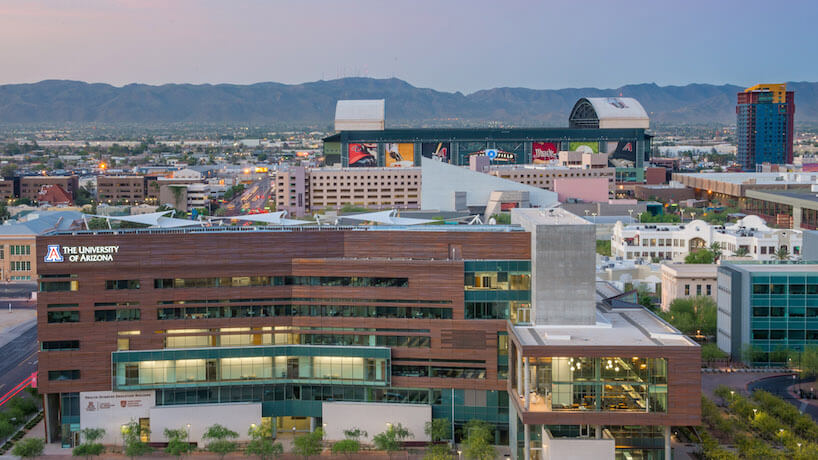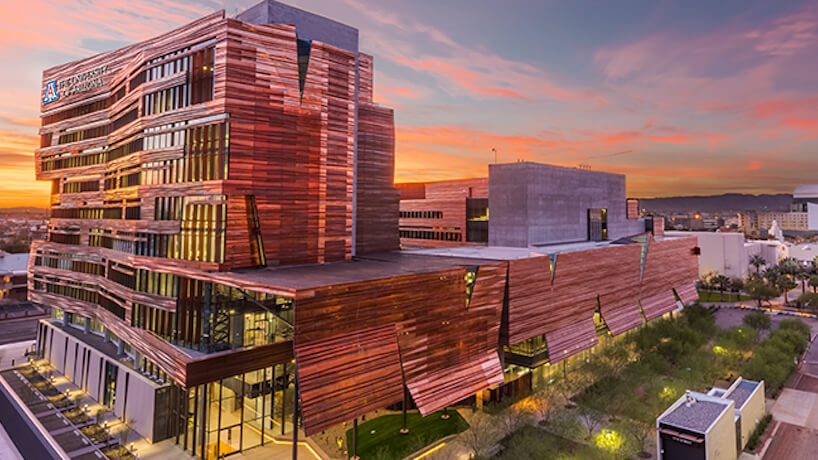When the Society of Critical Care Medicine (SCCM) was deciding where to host a simulation course to teach medical professionals a specific technique to keep patients alive, it wanted somewhere that could provide expansive conference facilities, in addition to state-of-the-art medical research technology.
SCCM found such a place in the Phoenix Biomedical Campus (PBC). “The facility was equipped with ample meeting space to hold our hands-on simulation course,” said Pam Dallstream, SCCM’s director of education. The course explored the fundamentals of ExtraCorporeal Membrane Oxygenation (ECMO), a technique providing prolonged cardiac and respiratory support to a person whose heart and lungs are unable to sustain life. “The large amphitheater for lectures and multiple breakout rooms easily accommodated course attendees, and the campus had the extensive equipment needed for the hands-on sessions.”
The PBC is a 36-acre urban medical and bioscience campus, offering more than 6 million square feet of academic and clinical space. “Since the biomedical campus is located adjacent to the Phoenix Convention Center, we like to think of the PBC as an extension of our learning environment,” said Lorne Edwards, vice president of sales and services at Visit Phoenix. “It’s a campus of higher education, offering both students and health-care professionals an innovative and immersive approach to advanced research applications as well as academic and clinical training.”
SCCM first held a course at PBC in January 2015 and the group has returned twice since then, in August 2015 and September 2016, each time for the Fundamentals of ECMO Management course, “a two-day simulation course that provided a comprehensive overview of ECMO programs,” Dallstream said. “Attendees rotated through lectures and simulation scenarios in which they learned how to identify the different components of the ECMO circuit and diagnose equipment malfunctions, how to determine the optimal ECMO settings in diseases commonly treated by ECMO, and how to recognize and manage the most common ECMO emergencies.”
Medical organizations can use the PBC’s University of Arizona Center for Simulation and Innovation, which includes an operating room, control room, and briefing rooms, and the Arizona Telemedicine Center, which boasts an amphitheater with HD videoconferencing capabilities. The PBC is also home to the Arizona Biomedical Collaborative, a $31-million research facility shared by Arizona State and the University of Arizona.

Dallstream says her experience hosting programs at the PBC have been seamless. “Staff members were very helpful,” she said. “Meeting space was easily accessible within the building, and it’s close to hotels and restaurants.” The PBC is within walking distance of more than 3,400 hotel rooms, according to Edwards, and borders the Phoenix Convention Center’s nearly one million square feet of flexible meeting and exhibition space.
Meeting organizers can also tap into the PBC’s roster of speakers, who are experts in education, research technology, and patient care. “We’re able to facilitate resources, including training or speakers, for health-care-related conventions,” Edwards said. “Having the PBC as part of our core convention footprint allows groups to develop and deliver programming and content to attendees in an experiential way.”
Earlier this year, the campus added the new University of Arizona research center, which includes labs for cancer, molecular medicine, and other health research. According to former UA President Ann Weaver Hart, the eco-friendly structure is meant to be a place for collaboration between those who make discoveries and those who implement them into everyday life. “It means that we’re in this together,” she told AZCentral.com.
Dallstream says the SCCM “would definitely consider returning to the campus if another simulation program is developed.” In fact, the organization is hosting its 2024 Congress at the Phoenix Convention Center, Jan. 21-24. “It’s very easy access to Phoenix from anywhere in the U.S. and it’s a quick drive from the airport to downtown Phoenix hotels,” she said. “There’s also a good selection of hotels and restaurants within walking distance to the convention center and the biomedical campus.”
The city of Phoenix “continues to be supportive of the growth of the PBC,” Edwards said. The campus currently offers the highest concentration of research scientists and professionals in the region, putting it on the “national map as a cutting-edge center for research and medical collaboration,” Phoenix Vice Mayor Kate Gallego told the Phoenix Business Journal. “It’s exciting to have Phoenix at the center of some of our most promising treatments to emerge in years for chronic and deadly diseases.”
Sponsored by


